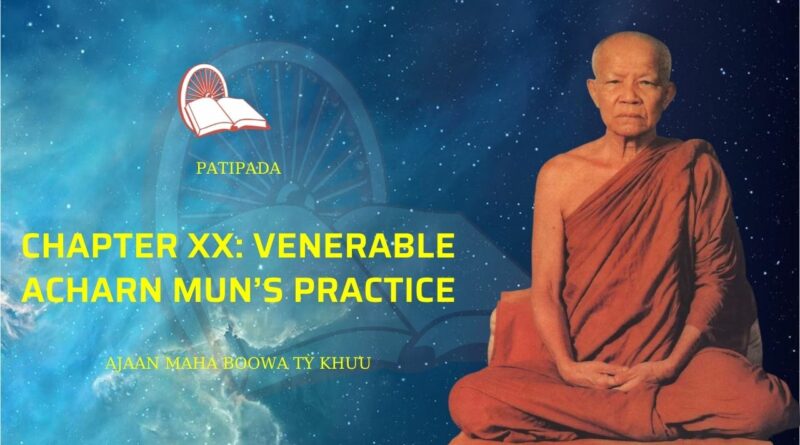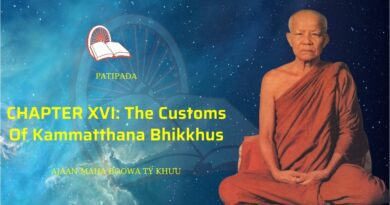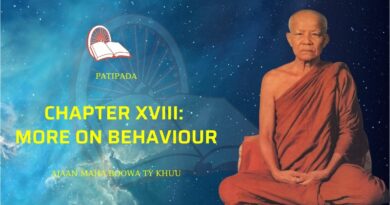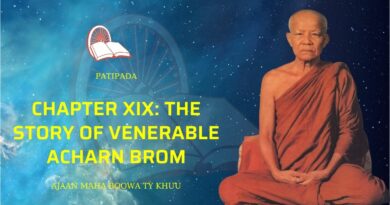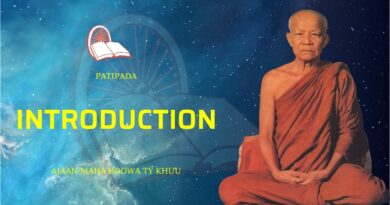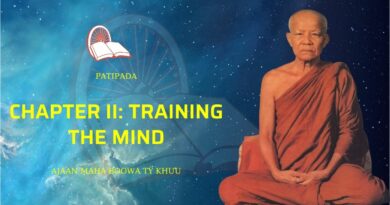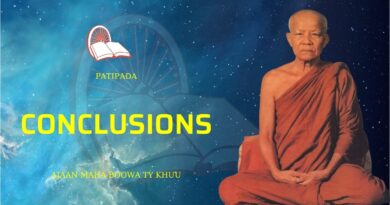PATIPADA – CHAPTER XX: VENERABLE ACHARN MUN’S PRACTICE
We are getting near the end of this book, so it is appropriate that we should discuss the methods of practising citta bhavana that Venerable Acharn Mun used, as well as the methods which he used in teaching those followers of his who went into training under him. This may act as sort of a guide to the way, in the form of a brief summary. But in particular, the way that he himself practised will first be considered, after which, the way he taught his close followers will be described. In this section, the names of the places where he practised and gained results will not be given, because they have already been detailed in his Biography. So the following account will only deal with his methods of practising citta bhavana and all external phenomena such as contact with Pretas, Ghosts, Devaputta, Devata, Nagas, Garudas etc., will be omitted as they have already been described.
The nature of Venerable Acharn Mun’s citta was unusually dynamic, venturesome, quick and sensitive to whatever events he came into contact with. To begin with, in doing the practice of bhavana, he used the preparatory repetition (parikamma) “Buddho….” As soon as his citta dropped into a concentrated, calm state, he saw a “nimitta”, sometimes of himself, dead in front of him, sometimes of a corpse in front of him — as has already been described in his Biography. Then he took that nimitta which had appeared before him as an indicator of the way his meditation practice should go from then on by defining it as being loathsome (patikula) in various ways, according to where his greatest skill in sati and pañña lay. He would sometimes define it as breaking down and decomposing until all that was left of it was a skeleton; then he would define the bones as separate from each other, scattered about right in front of him. Then sometimes he would also sweep them together in a heap, and set them up to be burnt by fire until they became ashes in front of him. Both the corpse and his own dead body were visual nimittas right there before him and he defined them in the same way, but at different times, just depending on whichever was suited to the contemplation he was doing.
After he had induced the fire to burn the bones down to fine ashes, his citta concentrated down to reach the basic level of samadhi in complete absorption and rested there for a long time, lasting for hours before withdrawing. As soon as his citta had withdrawn, he went on doing the same forms of practice as before. He said that from the day that his citta manifested these nimittas, and he could set them up to be as he wanted them, right through to cremating the remains of the corpse, he could go down and see them quite clearly in his heart at any time he wanted, regardless of whether he was standing, walking, sitting or lying down, for whatever his situation was, he would set up that corpse, which he had turned into a skeleton and see it as being attached intimately to his own body at all times. The only exception was at those special times when he contemplated that corpse in various ways after which the citta would then concentrate down into the state of samadhi and rest in itself alone for a while. At such times he had no interest or concern for anything.
He could see clearly how the strength of his citta began to develop and how he attained the foundation of samadhi firmly because of his having gained that nimitta, which acted like a grind-stone to sharpen up his sati and pañña all the time. He went on in this way until he was able to get the skeleton image of that nimitta to stay within his own body, so that his body and the skeleton became identified as one, and this went on until he had no doubt as to where this skeleton came from and who became this skeleton.
After this he gave up the practice of defining those characteristics. Because once the nimitta image had been entirely identified with himself it became unnecessary for him to define any external image. From then on he took up and defined his own body as the basis of his contemplation, and depending on the dexterity, skill and ability of his sati and pañña, he would contemplate the body, making it have any characteristics that he determined, as he wanted to. At this stage he said how he felt that his samadhi was very strong and stable, because of having depended on the contemplation of the body with pañña until the citta would relax and very easily concentrate down into samadhi.
The word “Buddho” which he had used as his preparatory repetition (parikamma) to control and direct the citta since he started to practise was dispensed with from the day when that nimitta appeared clearly before him. For he then aroused the nimitta with the parikamma “atthi” (bones) which acted as the supporting condition for the citta instead of “Buddho”. All the time he would define them and contemplate them by making them arise, making them change and break up right there in the body, and he would do this in all positions and situations, excepting only those times when he slept. He went on doing this until his body, although still there, turned into the space element (akasa–dhatu) in conformity with his contemplation. His citta was emptied of all material things such as the physical body, due to the coercive power of sati and pañña which contemplated without ceasing or letting go. He was then skilful in samadhi at all levels, and his vipassana (wisdom) at the level of rupa–dhamma (mind forms or images) was both skilful and very fast, to keep up with the mind. He said that vipassana of this level makes the citta shine very brightly and it is quite wonderful. If one is carelessly, looking only for pleasure and ease without one’s wisdom being clearly aware of the situation, one will probably become addicted and fascinated with this state of voidness thinking that it is Nibbana, without knowing within oneself by means of understanding, whether it is Nibbana for certain, or not. Because all of us have heard that Nibbana is voidness, enough for it to have become embedded in our hearts, but without knowing what characteristics Nibbana is void of. In particular, the kind of voidness which appeared at this time had something hidden within it. These were the subtle kilesas of his heart. How then could this ever be the voidness of Nibbana?
Before we can pass beyond the rupa–dhamma, which means the body both internally and externally, by means of various forms of contemplation, sati and pañña must be whirling around the body nearly the whole time. This excepts only those times when the citta of the one who is digging and searching has become weak and tired due to having done too much work; then he must take a rest by entering into the quiet calm of samadhi for a while.
As soon as he withdraws from samadhi, having regained his strength, he goes on with his contemplative investigation, disentangling the story of the body more and more by using the principle of the three characteristics (Ti–lakkhana) as the way to develop. Because the body is a thing of the greatest importance amongst those who practise the way, and with whatever subtlety and skill they are able to contemplate the body, to the same extent they will tend to become fearless and courageous in practising those methods which they use to progress. This is due to the fact that the body is the dwelling place of the more gross kinds of sexual craving (raga–tanha) and conceit (mana–ditthi), all of which live in dependence on the body quite frankly and openly. In some cases when people forget themselves and lose their restraint, displaying these things outwardly in a gross and vulgar manner, other people, even though they also have kilesas, cannot bear to see it and feel disillusioned, disgusted and fed up with it.
For the above reason, those who practise the way with the aim and full-hearted intention of destroying the kilesas, must keep their attention on the parts of the body (kaya–vibhaga) until they become skilled at it and can eliminate sexual craving bit by bit, in a way that is clearly apparent to themselves. As to the kilesa of conceit or opinionatedness, this is the kind of kilesa which is irritating and harmful and penetrates to the heart, one’s own and other peoples, more than any other kilesa. Generally, this kilesa lies, “just inside the door”, waiting for a chance to run out and display itself which it does very quickly, and it depends upon upadana — attachment — to the body as its main support. It is therefore taught in the Four Satipatthana (arousing of mindfulness) and the four Ariya Sacca (Noble Truths) which are amongst the most important Dhammas in the teachings of Buddhism, that one should contemplate kayagatasati (mindfulness of the body) much and often, until one has overcome all doubt about the body. Then one may pass beyond it, having got rid of all attachment to it.
Venerable Acharn Mun was accomplished and very skilled in the practice of mindfully contemplating the body (kayanupassana–satipatthana). He thus had a very wide and precise understanding of all aspects of Dhamma both inwardly and outwardly, and far beyond all others who were then practising the way. He said that when he went beyond body contemplation (kayagata), sexual craving ceased to be a problem from then on. This happened in such a way that it was quite unnecessary to ask or discuss it with anyone else (such as an Acariya). To do so would be a waste of time and would show up the stupidity of the one who asked, making a laughing stock of him. Because these are things within oneself, and things which disappear from oneself alone, due to the circumspection of sati and pañña at this level. Just by attaining the level at which sexual craving (raga–tanha) is destroyed and its “corpse” is expelled from the heart, is enough to bring ease and comfortable living to oneself, free from trouble and anxiety. Because sexual craving is a kind of craving which, so to speak, “eats without ever becoming satisfied”, and it disturbs and excites the heart, whispering and teasing suggestively and spreading its influence and dominance over the heart. This makes a person timid, scared, dispirited and feeble in making his way forward for the sake of the Path, Fruition and Nibbana, which is to be found in the sphere of the “Noble Truths” (Sacca–Dhamma) and the “setting up of mindfulness” (Satipatthana) and which may be reached by one who practises the way with effort and striving.
Venerable Acharn Mun also said that before the body was fully understood and ceased to be a problem in his contemplation of it, the body which he had contemplated in various ways concentrated together and entered into the sphere of the heart. Then all those thoughts and views (sankhara) associated with “uprising and promotion” (samudaya), which think of the body as being beautiful, shapely, pleasing and something which everyone has always been satisfied with, as well as all those thoughts and views associated with the Path (Magga) which conceptualised the body as being loathsome (patikula), undesirable and as being aniccam, dukkham and anatta, all died away at the same time as the image of the body which concentrated together and went into the heart. “Subha”, the beautiful and desirable aspect, and “asubha”, the ugly and undesirable aspect, were then both disposed of as paths for the heart to go along, so that it then passes by between these two Dhammas without any remaining attachment to them. No nimittas remained clinging on to the heart to deceive it with beauty or ugliness, and every time he did any contemplation of the body, he just saw the citta which displayed the body’s characteristics as an internal image which then died away and ceased.
From then on his citta was devoid of all material things including both the body which remained with him and all other things which existed externally. No more did he have any nimittas arising which were symbols of beauty (subha) and ugliness (asubha) as he used to prior to this stage. There was just brightness and a citta devoid of all things throughout its field, and it turned about in contemplation with mindfulness and wisdom acting as the driving force leading him onward.
The next thing that steadily became the focus of attention for mindfulness and wisdom to work on were: vedana — feeling, sañña — memory, sankhara — thought processes, and viññana — consciousness — which are the Dhammas that arise with, and cease simultaneously with, the heart; and also “avijja”, the origin and source of all the kilesas.
His Contemplation of the Paccayakara
Venerable Acharn Mun said:
“The Paccayakara may be divided into two aspects as described in the text books. The first is the inter-related process of arising and development of avijja; and the second is the process of the cessation of avijja which takes place step by step until nothing is left of it. This is analogous to the plan of a house which shows one how to built it from the start until it is completed. But even though when demolishing a house there is no plan of how to do it, such as that which shows the way to demolish avijja, it must rely upon the person who carries out the demolition to think out the way to do it before starting; and he must go about it with mindfulness and wisdom which are the pair of Dhammas that are needed to bring about the desired results.”
“In the old texts, the arising and ceasing of avijja is merely listed, thus: avijja is the condition (paccaya) which gives rise to the sankhara; sankhara is the condition which gives rise to viññana;… and so on, to… coming to birth (sambhavanti), all of which is on the side of ‘uprising’ (samudaya). On the other hand, the ceasing of avijja acts in a similar way as being the condition for the ceasing of sankhara, viññana, nama–rupa … and so on, the cessation of each one being the condition for the following one to cease. Then there are no kilesas remaining to act as the seed of further becoming and birth. This is the side of ‘cessation’ (nirodha) — as the old texts describe the end of avijja saying that it is ‘nirujjhanti’ (ceased or vanished).”
“But these two aspects of avijja, the first being the development and uprising of avijja, causing the citta to become associated with creating and branching out into the realms of existence and birth as animals and people, until it reaches old age, decrepitude and finally death; the second being the suppressing and removing of avijja so that it is entirely dispelled from the heart, thus ending the process of continual becoming and birth — as was done by all those, such as the Lord Buddha, who revealed Nibbana by quenching avijja, were both explained. Or rather the outline of the process that spreads out from avijja, as well as that which spreads out from the cessation of avijja, were explained. But it does not explain the method of increasing and developing avijja and how it is done so that avijja shall grow strong enough to lead beings endlessly through the round of birth and death. Nor does it explain the method of diminishing and destroying avijja and how it should be done, so that avijja shall be weakened steadily until it can be dispelled from the heart entirely, with no possibility of making that heart from which avijja has been dispelled fall back into the round of birth and death. For paccayakara only explains the above processes.”
“Someone, who practises to diminish and get rid of avijja, must depend on the Four Noble Truths or the Four Satipatthana as the way to do it. For these are the places in which avijja is concentrated. Venerable Acharn said that once his citta had entered into a state devoid of all rupa–dhamma, all that was left was to fasten onto the sankharas, viññana, and the vedana citta (the sankharas being the heart’s composers; viññana — consciousness — being that which contacts and acknowledges all kinds of things; and the vedana–citta — the feeling citta — being that which displays the results that become apparent, coming from the ‘composing’ and ‘acknowledging’ by way of viññana) with sati–pañña which also dwells in the same place as they do. Because the composing of the sankharas goes out from the citta and the acknowledging of viññana also goes out from the citta. All these things then variously die away and drop to the citta when sati follows and keeps up with them and pañña keeps on to them, finding out and critically analysing the situation as it unfolds and it is impossible for these things to develop and become strong.”
“Just following and knowing about what the sankharas and viññana are composing and acknowledging is not enough to satisfy the heart which has ‘automatic’ sati and pañña as its guardian the whole time without ever failing. For they can go still further, searching and digging down to the root, the origin where the sankharas and viññana arise, so as to know where they come from and what it is that drives them relentlessly and continually to arise, never letting up or stopping. In fact, the one that drives them on is the real avijja, and it is here that the contemplative investigation of avijja must take place in order truly to pull it out by the roots. In other words, to dig and search in the heart, which is where the house and home of avijja is deeply embedded, and then to see the body of avijja break up, disintegrate and fall away at the moment when Maha Sati and Maha Pañña reach it. This is the way to contemplate avijja and the right way to extract avijja from the heart by following the way of Magga (the Path) and Phala (the Fruition) which the Great Teacher rightly taught. It is not a way which is merely to be read about in the pages of the text books and then to be discussed and argued about incessantly until one’s mind is in a whirl, letting avijja make trouble and tease one and laugh in amusement. For not a single one of the kilesas is disturbed or hurt in the least by such discussions.”
“We are Buddhists with the one and only Great Teacher as our Teacher, and so we should use reason in following the Lord. We must not have mere opinions and conceit (ditthi–mana) as the only guide to our views and theories, as if the old text books were filled with kilesas and evil ideas, and then to indulge in argument and disputation with others — instead of curing the kilesas! All we get from doing this sort of thing is a lot of windy talk without any substance which one could hold to as being valuable. If we act in this manner, however much we learn and know when we enter the (boxing) ring of disputation, the more able we are the worse we become and there is no sign of the ‘man of wisdom’ left, who follows the way of the Great Teacher (Sasada) and his Teaching (Sasana–Dhamma).”
“The real avijja–tanha dwells in the heart. It has also built its organisation in the hearts of people and other beings, and it is only here in our hearts that we can weaken it and destroy it. The organisation of avijja–tanha never arises, nor is it built up, anywhere else, nor can its demolition take place anywhere else. When avijja has died and dropped away completely, then and then only can one see the stupidity, the delusion, the infatuation of all people and other beings who are subject to its compulsion and tyranny — and how this incredible stupidity and torment are there in them the whole time. Even though they do have some pleasure and happiness, it is short lived and fleeting like lightening flashes. Yet beings in the world are satisfied in their delusion and live together in a spell-bound manner, never thinking whether they are in danger of harm coming to them and how serious and extensive it may be.”
“But when such a person and his citta has been cleansed and well polished throughout, even though he remains the same person, he is entirely different from what he was, as different as the earth and sky. The citta, which has become free from the power of avijja, no longer remains within the limits of the restrictions that apply to all things in the relative world (loka–sammuti). For this citta is utterly free in a manner which is beyond the ability of anyone to guess or speculate about its nature, and this is what they call the realm of ultimate happiness. It is the ground of those who have power above and beyond the state of relative conventions, to possess it and experience it.”
“If we want to know and see this, we must not be lazy, for this laziness is a ploy of all the kilesas, tanha and avijja to lure us away. All of us here are Bhikkhus, complete with all that is necessary. We must rouse ourselves up! Don’t be dull and stupid and let the kilesas come out to display their conceit by behaving in a manner against the way of Dhamma, the Dhamma which leads us out of this mass of Dukkha. For to do this would be a waste of this life in which one has been born and become a vessel, well suited to the Sasana–Dhamma both in the circumstances of one’s birth and social status at the present time.” At this point Venerable Acharn finished his talk about avijja.
In this talk, Venerable Acharn, with metta, both showed us the valuable result which arises from the extraction of avijja, this being: “the knowing of freedom” (vijja–vimutti), as well as giving a sharp, stimulating talk on Dhamma to his followers once again, to act as a constant reminder to them which they would never forget. It made them “sit up and take notice” of it, as the reader may learn for himself in what we have written above.
Generally speaking, it was a characteristic of Venerable Acharn Mun when he talked of the higher levels of Dhamma, that his manner of speaking and behaviour displayed an intense concentration appropriate to each level of Dhamma. The effect of this on those who were not used to his behaviour was to make them apprehensive and afraid, thinking that he was scolding them and chastising them with his words. But in fact it was because the power of Dhamma is a force which was able to cause his mannerisms and behaviour to display these characteristics outwardly. Then as soon as he had finished his Dhamma talk, his manner returned to normal immediately; almost as if nothing unusual had happened a short time before. Sometimes he would even tell some amusing stories and laughter would break through his awesome manner. So nobody was ever able to penetrate and look into his character truly.
The explanation of avijja, which Venerable Acharn gave, has been recorded in the foregoing paragraphs. As to his explanation of how one gets free from avijja, which he also gave, it was extremely wide and extensive in scope and went right to one’s heart. But I’m afraid it was only practicable to give the gist of what he said, which is suitable for all of us who are still at the stage of learning. If we were to go too deeply into it, we probably would not understand and reading it would be a waste of time and would not bring us the value we should get from it.
Venerable Acharn Mun had no fixed or formal way of teaching. He had no preformed plan, no fixed formula, and no set courses of instruction which were pre-arranged according to a schedule of orderly and progressive teaching of texts, instructions or formal training of body, speech and mind like those institutions in the world which are set up for purposes of training. Instead, he upheld the Dhamma and Vinaya, which are a set of well grounded and tested principles, as the pattern for teaching and training his followers; and it depended on each individual to take up and practise whatever aspect of Dhamma both suited their disposition and their liking. If any of them came to Venerable Acharn and asked him questions based on their own level (bhumi) of citta and Dhamma, concerning things that had arisen and appeared out of their citta–bhavana, he would explain it all to them step by step and case by case. He never forced acceptance nor did he withhold anything in giving help with the Dhamma truth in his heart. But if nobody came to ask any questions he did not normally teach anything.
When the day came for a meeting to teach the Bhikkhus and Samaneras, Venerable Acharn would teach Dhamma as it is found in practice. He would teach it in a way that was generally applicable, starting from the lower levels of Dhamma, such as the methods of developing samadhi, steadily rising to the higher levels. He did this so that those who were at various stages of development could all gain benefit from his Teaching. As to the asking of questions, there were no limits, and it was up to those who had come to train under Venerable Acharn to ask about any aspect of Dhamma which they had doubts about in their hearts. It did not matter whether their questions were about external things such as the Pretas, Ghosts, Devaputta or Devata, or about internal things connected with samadhi or pañña, at any level. He would always clarify and explain what he was asked about in each and every case in whatever way was appropriate to the occasion.
For this reason, I feel sorry that all of you who read this were not able to get intimately close to him when he was alive. For then it would have been possible to see him with your own eyes and to have heard his Dhamma in a way that would have gone to your heart and dispelled all doubts and there would have been no uncertainty or need to guess how he looked and acted in various circumstances, such as those which we are considering at present. For in general, people have similar modes of knowing and feeling, as well as reasons why they listen and accept what is said. After having heard Dhamma from Venerable Acharn, which both externally and internally was replete with reason and so well expressed that it was a delight to hear and easy to accept and believe. It is unlikely that any of those who heard him would have dared to resist him and cling to their own speculations which had no underlying basis in reason, while speculating that what he said was true or not true as the drift of their thoughts inclined them. Because Venerable Acharn Mun always practised and acted with reason, and when he knew anything he would know it by the appropriate reasons, which were derived from the basis of practice by way of the heart. When what he knew flowed from him, it therefore always came out from a basis of reason and I never heard him talk in an inconsequential, aimless manner. Therefore, those who went to learn and train under him found it easy to have a deep and abiding faith in him and in all aspects of his Dhamma. This was also true of those aspects of Dhamma which they had not yet experienced, for what he said was so much in accordance with reason that it was easy to believe.
As for myself, I don’t feel that I am in any position to make out that I am particularly skilled or good in any special way at all — except perhaps in finding fault and blaming myself fearlessly and often. For there are so many blameworthy things in my heart that I could say it is almost overflowing with them. These things come under the heading of an opinionatedness (ditthi–mana) which does not readily give way to others without having first argued and contended to the limit. Only when I could see that my position was truly untenable would I give way, because there was no way left for me to go on arguing.
When it came to Venerable Acharn Mun, for whom I now have the greatest respect and reverence, before I was able to bow down and submit myself to him like someone who is worthless and hopeless, I had to observe him and listen to what he said and argue with him in the characteristic way of one who is obviously very opinionated. Sometimes when arguing with Venerable Acharn it seemed almost as if the Wat would break up and all the Bhikkhus and novices would run away in fright when they heard this cricket in debate against the great lion on the veranda of his hut. I used to argue “tooth and nail” using reasons that I thought were correct until finally I, who was like a cricket that has come to the end of its tune, had to bow down and submit to “wiping his feet” on me by letting him scold and upbraid me as he wished. If you who read this could have seen Venerable Acharn and the way he acted in various situations, as well as hearing the tone and manner in which he taught and trained us in Dhamma, like the Great Lion whose voice resounds with Dhamma Teaching of all kinds, you would probably have been truly amazed in the same way as all those who actually heard him. Then there would be little room left for uncertainty and doubt about how he looked and acted, nor about his knowledge and understanding of all sorts of aspects of Dhamma which one may otherwise feel uncertain about.
Those who would like a summary of the practice and manner of self-development which were used by Venerable Acharn should read what has been written about him in this book. Although what I have written about him is not very extensive or detailed in terms of the levels of Dhamma as high, medium or low, I think it will be enough to point out the way of practice for those who are interested. For if I were to put down things which are very unusual and detailed I’m afraid it would be too complex for the reader to work out and put into practice. This is due to Venerable Acharn’s knowledge of samadhi, pañña and vimutti (gaining freedom), which was extraordinarily broad and far beyond the level of all of us, to be able to follow and comprehend in all its aspects and details. So now it seems appropriate to bring this book of the practice of Venerable Acharn Mun to an end while it is still within my ability. Whether right or wrong, may the reader forgive me for whatever faults they find in it.
A Brief Summary of His Kammatthana Practice
In writing down the practice of Kammatthana of Venerable Acharn Mun, I have also brought in stories about many other Acariyas as well without revealing their names. Some of them are quite lengthy while others are short, as I only wrote about what was necessary. But I did not ask for their permission before doing so, and therefore I must apologise for this and ask forgiveness from all the Acariyas and all those others who practise the way whom I have written about here. I have done this for the help it can bring to people who are interested, both now and in future generations, for they will be able to take up these examples as guides for them to follow and practise. So the stories of these Acariyas and others can be of value to many people far into the future. In the same way as all of us who have depended on the many Acariyas and other people who have maintained the tradition of practice through past ages and up to the present day. Then they may be able to open their eyes and ears, enough not to be always vainly gazing, infatuated with the body of the human being, who should still be clever enough to have the sati and pañña to save themselves, both in the way of the world and Dhamma. This is why I have written down the manner of practice of these Acariyas and others to act as an indicator of the way to practise. So I hope in this way that it will be of value to some Bhikkhus, Samaneras and other people in general.
For any of you who read this book of the practice of Dhamma, if you find any part of it which suits your inclinations, please take it up and practise it in order to weaken and diminish the disorder and mess that is within each one of our hearts. This refers mostly to a reliance on our own self-orientated opinions, views and ways of doing things, which follow the policy of the kilesas and which generally lead us to be lazy in doing what we should be doing.
This practice will also be of value in developing calm and happiness, and the avoidance of restless disturbance both to oneself and others. This is the kind of work which the kilesas react against and do not like at all. But in anything that is worthless in so far as the right way of Dhamma is concerned, and anything that is harmful to oneself and others, they enjoy inciting us to do it all the time. The more we do of such things, the more the kilesas like them and promote them and think how good they are, even while oneself and the world get nothing but disturbance, trouble and blame from them, because these kinds of activities are neither right nor good.
When people have some Dhamma in their hearts they have a way to know what is right and wrong for themselves and they tend to be careful of what they do, not daring to risk doing anything that is bad and evil or wrong and harmful. In this way people are virtuous because their behaviour is controlled by Dhamma and they have value because of their behaviour. Animals are valuable because of their flesh, skin and other parts of their bodies, and also because of their strength and ability to do work. When an animal dies, its flesh, skin and the rest of the parts can be sold for money and this has always been a lucrative trade throughout the world, which enables people and other animals to gain benefit and strength. But when a person dies, the remains are of no value, and in fact they are objects of fear and repulsion. Though even when some of them are still alive they tend to amuse themselves in ways that make them give off a pervading stench due to their behaviour which cuts into their wealth and into the hearts of other people as well, causing damage and destruction and making people loathe and fear them greatly. When they die, nobody is sorry — in fact right the opposite, for hundreds or thousands of people have wished that they would die every day so that the earth may rise up a bit once it is relieved of the excessive burdensome weight of such people.
But by making oneself into a good person with knowledge, behaviour, duties and livelihood, all of which are clean and faultless, as a means of promoting one’s value, status, authority and good name, one turns oneself into a complete human being, one who will always be of priceless value. Such a person will be revered and accepted in the world without being disliked by anyone, and his honour and reputation will spread abroad like a sweet scent going against the wind. People living all over the place will admire his merit and perfection of character (parami); and when he dies it will only be the body which disintegrates, whereas all his value and virtue will still be abroad in the world, for it does not disintegrate with the body.
It seems to me that this book of practice may therefore act as an ornament to those who practise the way and also to the “Kammatthana Circle”, enabling them to maintain their elevated status for a long time into the future. For these are the practices which have brought results to those who committed themselves wholeheartedly to whatever aspect of these practices they did, in accordance with their tendencies of character. It is for this reason that this book of practice deals with many forms of practice, many choices and many conditions of life which the readers may use as it suits their various different characteristics, and from which they may get appropriate results. So all these things have been brought together in this one book to make it convenient for those who are interested enough to choose whatever suits their temperament and to put it into practice for their own future benefit.

